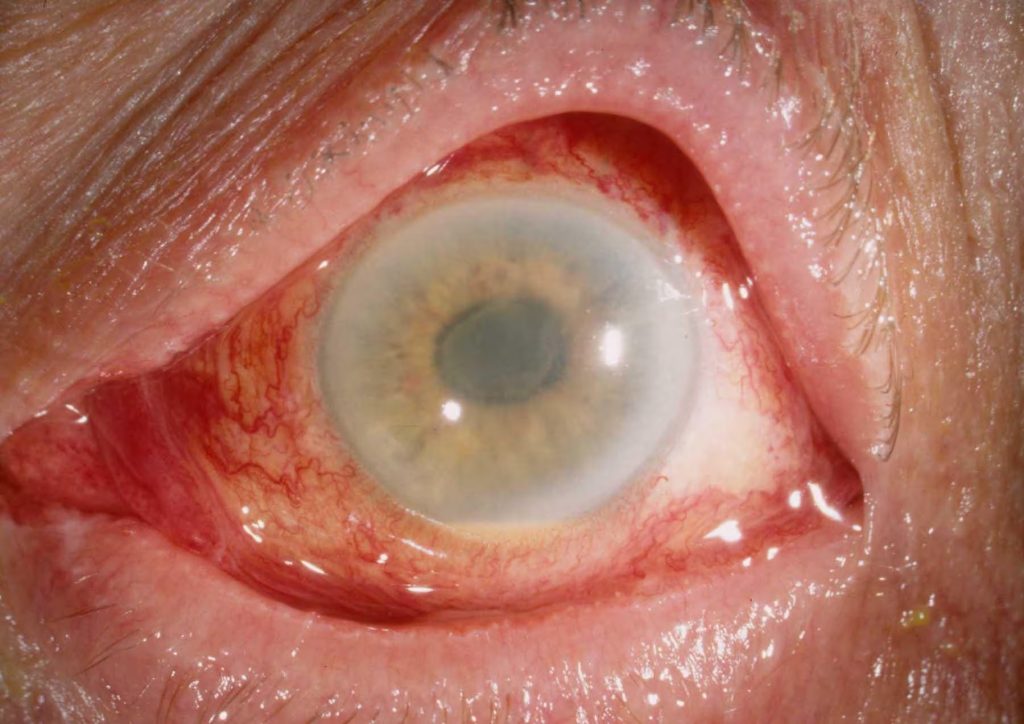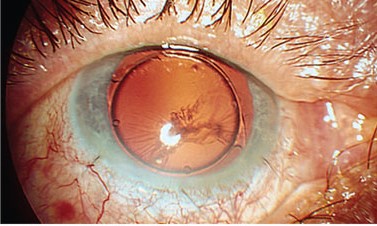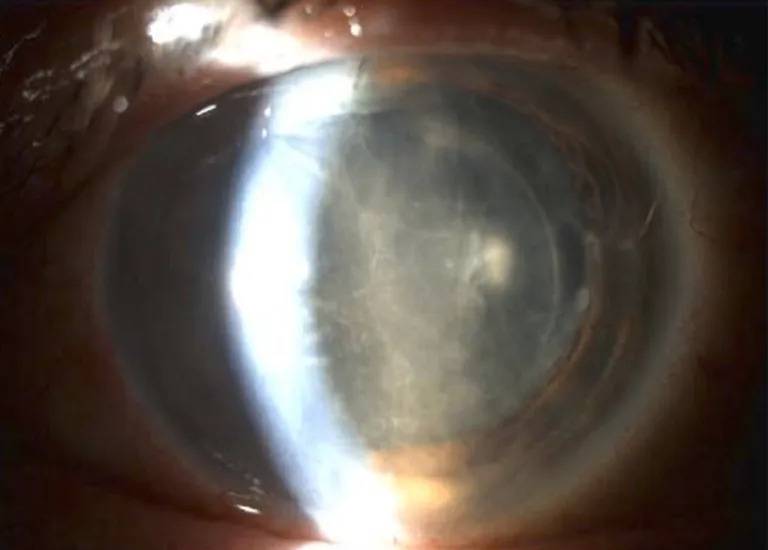CASE REPORT
A 65-year-old female with a medical history of controlled hypertension presented with a sudden decrease in vision, severe eye pain, and redness in the right eye 48 hours after uncomplicated phacoemulsification cataract surgery.

Clinical examination revealed reduced visual acuity to counting fingers at 1 meter, conjunctival injection, corneal edema, elevated intraocular pressure, and limited fundus examination due to corneal edema.
Despite initial concerns for postoperative infection, laboratory tests ruled out bacterial and fungal endophthalmitis, supported by the absence of vitritis and unresponsiveness to broad-spectrum antimicrobial therapy.
The diagnosis of Toxic anterior segment syndrome (TASS) was considered.
DISEASE
Toxic anterior segment syndrome (TASS) is an acute severe intraocular inflammation accompanied by diffuse corneal edema within 1-2 days of anterior segment surgery which is most commonly associated with cataract surgery.
TASS is a form of sterile, noninfectious endophthalmitis with or without pain, a marked decrease in vision, diffuse corneal edema that extends limbus to limbus, photophobia, and severe anterior chamber reaction, occasionally with hypopyon.
Toxic anterior segment syndrome (TASS) presents within 12-24 hours after surgery whereas infectious endophthalmitis typically develops 2-7 days after surgery. TASS is responsive to topical steroids in most cases.
The etiology of TASS may be multi-factorial with numerous potential causes.
- Bacterial endotoxins or particulate contamination of balanced salt solutions
- Intraocular irrigating solutions with abnormal PH, osmolarity, or ionic composition
- Denatured Ophthalmic viscosurgical Devices (OVD)
- Intraocular medications (antibiotics in the irrigation solutions or intracameral antibiotics)
- Topical ointments
- Inadequate sterilization of surgical instruments and tubing
- Inadequate flushing of instruments between cases resulting in build-up of ophthalmic viscosurgical devices (OVD)
- Preservatives
- Metallic precipitates

Eye examination
A full examination is very important. Evaluation of visual acuity, pupil size and reaction, slit-lamp exam, eye pressure, and dilated fundus exam.
Symptoms
- Vision loss or blurry vision within 12-48 hours after surgery
- Pain ranging from mild to severe
- Photophobia
Signs
- The acute severe inflammatory reaction of the anterior chamber within 12-48 hours after surgery
- Corneal edema extending from limbus to limbus
- Dilated or irregular pupil
- Increased intraocular pressure
- Hypopyon
- Lack of bacterial or fungal growth from cultures of intraocular taps
- Good response to topical ophthalmic steroid drops
MANAGEMENT
Medical therapy
Most Toxic anterior segment syndrome (TASS) patients respond well to topical corticosteroids (1% Prednisolone acetate) given hourly. Mild or early cases will respond to steroids rapidly as evidenced by the clearing of the inflammation and a decrease in intraocular pressure.

In cases of moderate TASS, the clearing may take up to 3-6 weeks. In severe cases, which may need systemic steroids, there may be permanent damage, including persistent corneal edema, chronic persistent inflammation, fixed dilated pupils, refractory glaucoma secondary to trabecular meshwork damage, and cystoid macular edema.
Medical follow up
The patient should be followed very closely, especially for several hours and days after the onset of treatment. The patient needs to be evaluated for recovery and response rate.
The eye pressure, level of inflammation, and corneal recovery should be observed. A gonioscopy examination is necessary to rule out retained lens fragments.
Surgery
Toxic anterior segment syndrome (TASS) is a post-surgical event after an anterior segment surgery.
If TASS develops, then there is usually a need for intraocular aqueous and vitreous tap for culture. In severe cases of TASS with persistent corneal edema, patients may need corneal transplantation.
In refractory glaucoma, the eye pressure should be closely monitored. If the pressure is not responsive to medical management, glaucoma surgery may be necessary.
Of note, in a major outbreak of 147 eyes published by Oshika et al, 29.3% of cases required surgery, including irrigation of the anterior chamber, vitrectomy, and IOL removal.
Complications
- Severe inflammation
- Pain
- Vision loss
- Iris atrophy either dilated or irregular pupil
- Cornea endothelial damage with corneal edema
- Trabecular meshwork damage with possible secondary glaucoma
Prognosis
Most cases of Toxic anterior segment syndrome (TASS) are successfully treated with topical steroids, non-steroidal anti-inflammatory drops, or both.
If not resolved after 6 weeks, permanent damage is more likely to occur.
The intense inflammatory reaction can cause serious damage to intraocular tissues including the corneal endothelium, which results in cornea edema, iris (either dilated or irregular pupil, and atrophy), and trabecular meshwork damage with possible secondary glaucoma. Tissue damage can result in vision loss.
HOW TO TAKE SLIT-LAMP EXAM IMAGES WITH A SMARTPHONE?
Smartphone slit-lamp photography is the new advancement in the field of science and technology in which photographs of the desired slit-lamp finding can be taken with smartphones by using the slit-lamp adapters.
Slit-lamp Smartphone photography
REFERENCES
- Manson MC, Mamalis N, Olson RJ. Toxic anterior segment inflammation following cataract surgery. J Cataract Surg 1992; 18: 184-189
- Mamalis N, Edelhauser HF, Dawson DG, Chew J, LeBoyer RM, Werner L. Toxic anterioe segment syndrome. J Cataract Refract Surg 2006; 32: 324-333
- Carolee M. Cutler Peck, Jacob Brubaker, Sue Clouser, Chris Danford, Henry E. Edelhauser, Nick Mamalis Toxic anterior segment syndrome: Common causes Journal of Cataract & Refractive Surgery July 2010; Vol. 36(Issue 7): 1073-1080
- Oshika T, Eguchi S, Goto H, Ohashi Y. Outbreak of Subacute-Onset Toxic Anterior Segment Syndrome Associated with Single-Piece Acrylic Intraocular Lenses. Ophthalmology. 2017;124(4):519e23
- Hernandez-Bogantes E, Navas A, Naranjo A, Amescua G, Graue-Hernandez EO, Flynn HW Jr, Ahmed I. Toxic anterior segment syndrome: A review. Surv Ophthalmol. 2019;64(4):463-476.
Slit-lamp Smartphone photography

RETINAL IMAGING BY YOUR SMARTPHONE


